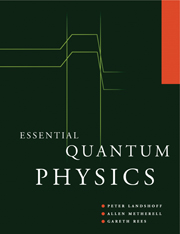Book contents
- Frontmatter
- Contents
- Preface
- Constants of quantum physics
- 1 Preliminaries
- 2 The Schrödinger equation
- 3 Special solutions
- 4 The superposition principle
- 5 The hydrogen atom
- Revision quiz
- 6 The hydrogen molecule
- 7 Introduction to perturbation theory
- 8 Spin
- 9 Masers and lasers
- 10 Band structure of crystals
- 11 Electron motion in crystals
- 12 Transistors
- Appendices
- Hints for the problems
- Index
6 - The hydrogen molecule
Published online by Cambridge University Press: 05 June 2012
- Frontmatter
- Contents
- Preface
- Constants of quantum physics
- 1 Preliminaries
- 2 The Schrödinger equation
- 3 Special solutions
- 4 The superposition principle
- 5 The hydrogen atom
- Revision quiz
- 6 The hydrogen molecule
- 7 Introduction to perturbation theory
- 8 Spin
- 9 Masers and lasers
- 10 Band structure of crystals
- 11 Electron motion in crystals
- 12 Transistors
- Appendices
- Hints for the problems
- Index
Summary
In chapter 5 we saw how in quantum mechanics electrons are bound to nuclei so as to form atoms. We now give a rather abbreviated account of how atoms bind together to form molecules. There is more than one type of molecular binding. We shall confine our discussion to the type known as covalent binding. The possibility of this type of binding relies on an effect that is peculiar to quantum mechanics, the tunnel effect, which we have already encountered in chapter 3.
The ionised hydrogen molecule
The simplest molecule is the ionised hydrogen molecule, which consists of two protons and one electron. The Coulomb force between the two protons tends to push them apart; we investigate how the presence of the electron overcomes this repulsion and holds the molecule together.
An exact calculation is difficult, but we can discuss the general features of the bonding by making suitable approximations. As the protons are much heavier than the electron, we may neglect their motion compared with that of the electron, and so regard them as fixed. We show that the expectation value of the energy, considered as a function of the proton separation R, has a minimum for a certain value of R, so that there is a stable equilibrium configuration.
Suppose first that R is so large that in the vicinity of each of the protons the Coulomb field of the other is completely negligible.
- Type
- Chapter
- Information
- Essential Quantum Physics , pp. 63 - 69Publisher: Cambridge University PressPrint publication year: 1997



